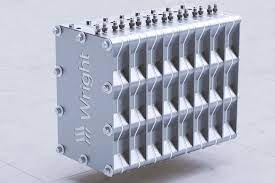Jeff Engler of Wright Electric wants it all. He wants lightweight, high-power electric motors and inverters to control them. He wants lightweight generators and now lightweight, high energy density batteries to store that electricity. He wants to meet the goal that, “By 2040, Wright will eliminate carbon emissions from all flights under 800 miles.” A more recent iteration of the company’s web site includes the goal of “Decarbonizing the industries that are hardest to decarbonize.” These would seem heady ideals but Wright Electric seems to be making steady progress toward fulfilling those goals. The Motor Their motor has been tested to 1,000 kilowatts (1,340 horsepower), with expectations that it could reach 2,000 kW (2,680 hp.). According to Aviation Week, “The motor produced 1 megawatt of peak power on a dynamometer test stand at Wright’s facility in Albany, New York. The company has signed a Space Act Agreement with NASA to test the motor in an altitude chamber at the NASA …
Electric seagliders Skimming Coastal Waters
REGENT seaglider Skimming the Waves WIGs are Wings in Ground Effect, a type of flight that keeps one just above the sea’s surface. Simplified, when a wing is at an altitude less than its span, it operates in a ground effects cushion that adds lift. According to backers of REGENT’s seaglider, such a craft can skim the waters in low-level flight while providing transport cheaper and quicker than water-borne alternatives. CNN reports, “…a Boston-based start-up backed by some of Silicon Valley’s most prominent investors wants to turn the sea lanes along the country’s east and west coasts into high-speed transit corridors.” The firm identifies their company name as an all-caps, proper noun acronym – Regional Electric Ground Effect Nautical Transport. They denote the “seaglider” as a common noun describing the type of craft they are building. It combines WIG technology with hydrofoils, and in the process gains an odd certification for an airplane. Classified as a seagoing vessel, it will …
From Ganged Motors to Wright’s Two MegaWatts
Twelve years ago, your editor gave his first talk at an electric aircraft symposium. Dr. Brien Seeley asked that he include all motors up to 100 kilowatts in his talk – at that time a rarity. Designers often had to “gang” small motors to drive a single propeller to obtain the necessary power. Now, Wright Electric has announced its plans to develop motors (and associated equipment) in the 500 kilowatt to 20 megawatt range. Motors of those sizes are still under development, but Wright claims to have tested and demonstrated “a megawatt-class, high performance inverter,” according to Green Car Congress. Jeff Engler is getting recognized for his vision. Here he give his virtual elevator speech at the Davos, World Economic Forum. His positive and yet measured approach seems to gain acceptance for that vision. Demonstrated Performance? Aiming for some audacious levels of performance, Wright’s inverter could hit these metrics: “99.5% efficiency –a 6x improvement in heat loss over current in-production …
Paris to London Using No Fossil Fuels
Jeff Engler fired up a start-up, Wright Electric, about a year ago. Last week, he presented at the Y Combinator Winter 2017 Demo Day – a semi-annual event where venture capitalists can meet the latest in venturesome mendicants. Tech Crunch describes the firm’s goals, which include electric flights between London and Paris on no fossil fuels – ambitious to say the least. “Wright Electric wants to build the world’s first electric airplane (at least the first 150 seat electric airliner). One of the main reasons airlines like Southwest can offer low fares is that they pre-purchase gas, but Wright sees an opportunity to make flights even cheaper by using electric planes instead. The company is targeting the 30 percent of all flights that are 300 miles or less, and is partnering with EasyJet to start. As technology improves, it believes its planes will be able to go after the $26 billion short-haul flight market.” Jeff has managed to attract a …




